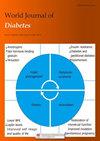Accuracy of FreeStyle Libre flash glucose monitoring in patients with type 2 diabetes who migrated from highlands to plains
IF 4.2
3区 医学
Q1 ENDOCRINOLOGY & METABOLISM
引用次数: 0
Abstract
BACKGROUND The FreeStyle Libre flash glucose monitoring (FGM) system entered the Chinese market in 2017 to complement the self-monitoring of blood glucose. Due to its increased usage in clinics, the number of studies investigating its accuracy has increased. However, its accuracy has not been investigated in highland popu-lations in China. AIM To evaluate measurements recorded using the FreeStyle Libre FGM system compared with capillary blood glucose measured using the enzyme electrode method in patients with type 2 diabetes (T2D) who had migrated within 3 mo from highlands to plains. METHODS Overall, 68 patients with T2D, selected from those who had recently migrated from highlands to plains (within 3 mo), were hospitalized at the Department of Endocrinology from August to October 2017 and underwent continuous glucose monitoring (CGM) with the FreeStyle Libre FGM system for 14 d. Throughout the study period, fingertip capillary blood glucose was measured daily using the enzyme electrode method (Super GL, China), and blood glucose levels were read from the scanning probe during fasting and 2 h after all three meals. Moreover, the time interval between reading the data from the scanning probe and collecting fingertip capillary blood was controlled to < 5 min. The accuracy of the FGM system was evaluated according to the CGM guidelines. Subsequently, the factors influencing the mean absolute relative difference (MARD) of this system were analyzed by a multiple linear regression method. RESULTS Pearson’s correlation analysis showed that the fingertip and scanned glucose levels were positively correlated (R = 0.86, P = 0.00). The aggregated MARD of scanned glucose was 14.28 ± 13.40%. Parker's error analysis showed that 99.30% of the data pairs were located in areas A and B. According to the probe wear time of the FreeStyle Libre FGM system, MARD1 d and MARD2–14 d were 16.55% and 14.35%, respectively (t = 1.23, P = 0.22). Multiple stepwise regression analysis showed that MARD did not correlate with blood glucose when the largest amplitude of glycemic excursion (LAGE) was < 5.80 mmol/L but negatively correlated with blood glucose when the LAGE was ≥ 5.80 mmol/L. CONCLUSION The FreeStyle Libre FGM system has good accuracy in patients with T2D who had recently migrated from highlands to plains. This system might be ideal for avoiding the effects of high hematocrit on blood glucose monitoring in populations that recently migrated to plains. MARD is mainly influenced by glucose levels and fluctuations, and the accuracy of the system is higher when the blood glucose fluctuation is small. In case of higher blood glucose level fluctuations, deviation in the scanned glucose levels is the highest at extremely low blood glucose levels.FreeStyle Libre Flash 血糖监测仪对从高原迁移到平原的 2 型糖尿病患者的准确性
背景 FreeStyle Libre 闪光灯血糖监测(FGM)系统于 2017 年进入中国市场,作为自我血糖监测的补充。由于其在诊所的使用率越来越高,对其准确性进行调查的研究也越来越多。然而,在中国高原地区尚未对其准确性进行调查。目的 对 3 个月内从高原迁移到平原的 2 型糖尿病(T2D)患者使用 FreeStyle Libre FGM 系统记录的血糖与使用酶电极法测定的毛细血管血糖进行比较评估。在整个研究期间,每天使用酶电极法(Super GL,中国)测量指尖毛细血管血糖,并在空腹和三餐后 2 h 从扫描探头读取血糖水平。此外,从扫描探头读取数据到采集指尖毛细血管血液的时间间隔控制在小于 5 分钟。根据 CGM 指南对 FGM 系统的准确性进行了评估。随后,采用多元线性回归法分析了影响该系统平均绝对相对差值(MARD)的因素。结果 皮尔逊相关分析表明,指尖血糖水平和扫描血糖水平呈正相关(R = 0.86,P = 0.00)。扫描葡萄糖的总 MARD 为 14.28 ± 13.40%。根据 FreeStyle Libre FGM 系统的探针磨损时间,MARD1 d 和 MARD2-14 d 分别为 16.55% 和 14.35%(t = 1.23,P = 0.22)。多元逐步回归分析表明,当血糖偏移最大振幅(LAGE)< 5.80 mmol/L时,MARD 与血糖无相关性,但当 LAGE≥ 5.80 mmol/L 时,MARD 与血糖呈负相关。结论 FreeStyle Libre FGM 系统对新近从高原移居平原的 T2D 患者具有良好的准确性。该系统可能是避免新近迁移到平原地区的人群因血细胞比容过高而影响血糖监测的理想选择。MARD 主要受血糖水平和波动的影响,当血糖波动较小时,系统的准确性较高。在血糖水平波动较大的情况下,极低血糖水平时扫描血糖水平的偏差最大。
本文章由计算机程序翻译,如有差异,请以英文原文为准。
求助全文
约1分钟内获得全文
求助全文
来源期刊

World Journal of Diabetes
ENDOCRINOLOGY & METABOLISM-
自引率
2.40%
发文量
909
期刊介绍:
The WJD is a high-quality, peer reviewed, open-access journal. The primary task of WJD is to rapidly publish high-quality original articles, reviews, editorials, and case reports in the field of diabetes. In order to promote productive academic communication, the peer review process for the WJD is transparent; to this end, all published manuscripts are accompanied by the anonymized reviewers’ comments as well as the authors’ responses. The primary aims of the WJD are to improve diagnostic, therapeutic and preventive modalities and the skills of clinicians and to guide clinical practice in diabetes. Scope: Diabetes Complications, Experimental Diabetes Mellitus, Type 1 Diabetes Mellitus, Type 2 Diabetes Mellitus, Diabetes, Gestational, Diabetic Angiopathies, Diabetic Cardiomyopathies, Diabetic Coma, Diabetic Ketoacidosis, Diabetic Nephropathies, Diabetic Neuropathies, Donohue Syndrome, Fetal Macrosomia, and Prediabetic State.
 求助内容:
求助内容: 应助结果提醒方式:
应助结果提醒方式:


